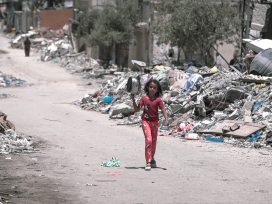Along with India and China, Russia has the fastest growing HIV infection rate in the world. Yet there is no sex education in schools, no HIV/AIDS awareness programme and a profound reluctance to admit to the problem at official levels.
There was relief tempered with incredulity in Russia when deputy health minister Gennady Onishchenko announced a 50 per cent decrease in the number of new HIV cases for 2002: just 41,000 as opposed to the 77,200 registered the previous year.
This remarkable drop was put down to tougher law enforcement and the collapse of the Taliban leadership in Afghanistan. The regime had been a major supplier of drugs to Western Europe via Kazakhstan, and Russia was becoming a dumping ground for cheap heroin. Records showed that the spread of HIV/AIDS doubled in 1999, a year when heroin consumption here also rocketed. But now all that was under control. The total number of deaths was still just a little over 2,000, and about 5,000 AIDS patients were being treated by the state. The first AIDS hospice was opening in St Petersburg; HIV-positive foreigners were being deported; and the Baltic enclave of Kaliningrad was holding a LIVE AID-style concert to raise money and awareness. Five thousand people came, including Russia’s First Lady, Lyudmila Putin. The President himself hadn’t once mentioned the issue in public, it is true, but this is a big and complicated country of 144 million people with an ingrained tradition of public discretion. He probably had other priorities and who could complain that nothing was being done?
Vadim Pokrovsky, director of Moscow’s Centre for AIDS Prevention and Treatment, for one. The 50 per cent fall in the HIV infection rate was a very misleading statistic, he told journalists. The health ministry had stopped paying for HIV tests forcing regional authorities to pick up the cost. Fewer people than ever were being tested. Pokrovsky estimates that up to 1.2 million Russians are infected with HIV (official figures currently stand at 250,000). Unless urgent measures are taken there could be 5 million HIV positive people living in Russia by 2007. Two million are expected to die within 15 years, but there are fears the figure could rise as high as 7 million. Along with Ukraine, India and China, the Russian Federation has the fastest growing HIV infection rate in the world. A 6 per cent fall in population is expected if 3 per cent are infected: a demographic crisis could be imminent.
Russia’s birth rate is low, its mortality rate high and, as Valery Abramkin warns, a TB epidemic is growing. But for the moment, on street corners, in hotel lobbies, nightclubs, subways, markets, libraries and schools, AIDS is but a latent presence. The untreated will not begin to die in their thousands for a decade: that is when the labour force, higher education and the military will be hit. In December 2002, UPI reported that one third of conscripts were already deemed unfit for service due to HIV or hepatitis. In some areas around Moscow, 5 per cent of young people have AIDS. Up to 15 per cent of Moscow’s prostitutes may be infected. Figures are unreliable because the vulnerable do not come forward for testing or treatment. They fear ostracism; they fear the facts; and, most immediately, they fear arrest.
An estimated 90 per cent of HIV positive Russians are intravenous drugs users and, according to a law passed in 1998, addiction is a crime. The possession of 0.005 grams of heroin can give a user three years in prison. Sentences for hoarding drugs can extend up to 15 years. Sterile injecting equipment is available without prescription, but with such draconian laws still in place who would want to advertise the habit by running to a pharmacist? Needle-sharing is part of the life-style and to refuse to do so can cause deep offence.
In areas where joblessness and poverty are the norm, the drugs trade carries enormous economic incentives. Intravenous users are estimated to infect two or more people with HIV every year. A significant proportion of those affected are occasional, ‘”social” injectors – and the virus spreads to partners, children, hospitals. Many victims are women from the provinces working as prostitutes in big cities. Most are under 25. Those who are arrested may shuttle between prison and the streets for years. An overcrowded and corrupt penal system fuels drug abuse, prison regulations notwithstanding. Home-made drugs and syringes are passed from hand to hand; condoms are restricted because of a notional prohibition on sex. Methadone treatment for heroin addiction is illegal. The number of HIV positive prison inmates has risen ten times over the past 30 months. According to the Moscow Centre for Prison Reform, 50 per cent of Russians infected with HIV are former prisoners.
A survey taken last year showed that one third of Russians think that anyone known to be HIV positive should be isolated from the community. There have been reports of fearful doctors refusing to provide care and schools refusing to admit infected pupils. A law passed in 1995 guarantees people with HIV anonymity, medical care and counselling, and the public – information, epidemiological surveillance and education. Yet the HIV positive sector of the community is shunned, sacked, mistreated and branded as degenerate. When Medecins sans Frontières launched a pioneering needle exchange programme in Russia in 2002, their vehicles were torched. AIDS is widely viewed as a foreign problem which has infiltrated communities of drugs users, gays, and prison inmates, and will stay with the undesirables if decent people are careful. The Russian Orthodox Church has objected to cinema ads promoting safer sex, and billboards promoting the use of condoms raised complaints from the authorities that they were harming public morals. But official prudery apart, Russians take pride in sleeping around, and the possibility of heterosexual transmission raises few real qualms. Sex is freedom, risk is joy, and hygiene or sanitation are not always the highest priorities. In 2000, 3 per cent of HIV transmissions were from heterosexual sex. By August 2002 this had leapt to 11 per cent.
The upshot has been a rude awakening in the Duma to the fact that 80 per cent of those infected with HIV are under 30. In June, the Moscow Healthcare Department called for compulsory measures to register and treat all HIV/AIDS patients. Of the 22,000 already registered in the capital, only about 1,000 are coming forward for treatment. There is widespread mistrust of the medical establishment, its attitudes and the insanitary conditions in which health workers operate.
According to Pokrovsky, the long-term danger lies above all in public ignorance about living with AIDS and the state’s reluctance to put funds into a national information campaign that would raise awareness. Even though about 30 NGOs have been working on HIV/AIDS in Russia since the mid-1990s, networking has been poor and information fails to reach those who need it most. Future costs of treating people could be prohibitive for government. At present, Russia spends about US$5million a year on HIV/AIDS – an amount that covers the treatment of just 500 patients. An adequate public information campaign would cost US$75 million.
In 2003, Russia committed less than US$6 million to its domestic AIDS programme, but gave a grand US$20 million to the Global Fund to Fight AIDS. Two years ago, it blocked a US$150 million loan offered by the World Bank to fight AIDS and TB on the grounds that it did not wish to incur any further foreign debt. Apparently, the government does not want to be seen to be begging for funds from the international community – especially for this.
Under the Soviet regime, the synonym for sex most favoured by official writers was “this…business” (eto delo). There is still profound reluctance to discuss sex-related issues publicly in Russia. It is inappropriate; the context is wrong; you just don’t do it. There is no effective sex education in schools. So it comes as no surprise that not a single public figure has acknowledged being infected with HIV – though Pokrovsky is reported to have treated “a handful”.
Thankfully, behind the scenes, there are signs of a tentative awakening. Earlier this year, the Duma passed the first draft of a law which may at last differentiate between drugs users and drugs pushers, treat addicts more leniently, and significantly cut the numbers of people with HIV in penal institutions by 2005. The question then will be whether the government can provide the necessary medical and welfare support for all those released from prisons and penal colonies into towns, cities and villages where people are suspicious, anxious, impoverished, ill-informed and, sometimes, angry.
Published 24 March 2004
Original in English
First published by Index on Censorship
Contributed by Index on Censorship © Irena Maryniak / Index on Censorship / Eurozine
PDF/PRINTNewsletter
Subscribe to know what’s worth thinking about.



